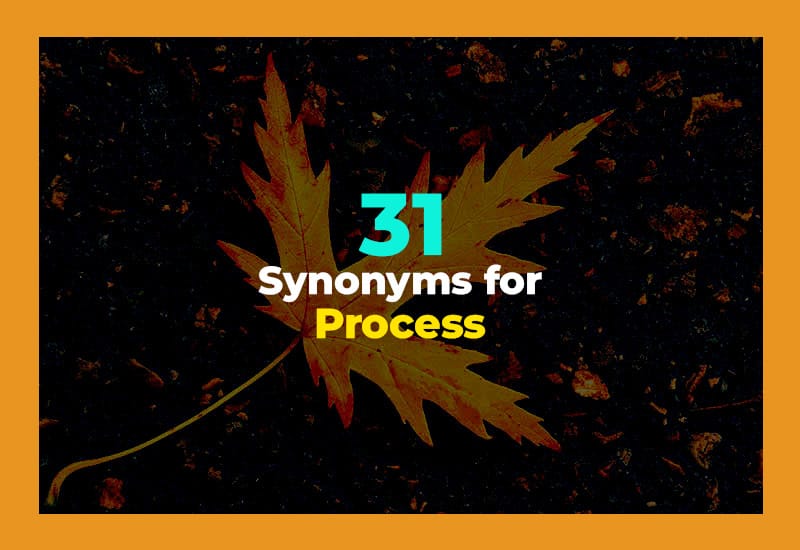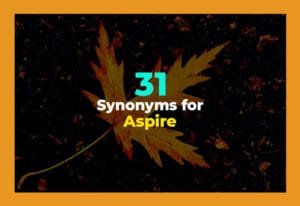You know when you keep hearing the word ‘process’ over and over, and you’re like, there's gotta be a better way to say this? Well, you’re not alone! Whether you’re writing, speaking, or just trying to sound a little more interesting at work or school, having a few fresh words up your sleeve can be a game-changer. In this post, I'm sharing 31 simple and easy synonyms for the word ‘process’ that you can start using right away.
1. Procedure
A procedure is a set of steps you follow to do something in a certain way. It’s like a recipe. If you’re baking a cake, the recipe instructions are the procedure. In school or work, people follow procedures to make sure things go right. For example, doctors follow a surgery procedure to keep patients safe. Or you might follow a morning procedure like brushing your teeth, taking a shower, and having breakfast. It’s all about doing things in the right order to get a good result.
2. Method
A method is a way of doing something, usually planned and tested. It’s like a strategy that helps you reach a goal. If you’re trying to learn math, your study method might be using flashcards or watching videos. Cooks have different cooking methods, like baking, frying, or steaming. Each method helps you get a different result. A good method can save time and give better outcomes. When you’re stuck, trying a new method can make things easier and more fun.
3. Approach
An approach is how you choose to deal with something. It’s your style or angle. For example, if you’re solving a problem, your approach might be to ask for help or break it into parts. Teachers use different teaching approaches to help students learn better. Some are more fun or more serious. If you’re painting a picture, your artistic approach can make it look totally unique. So your approach shapes how you do things and what results you get.
4. Technique
A technique is a special way to do something skillfully. Artists, athletes, and even students use techniques to do better. For example, a soccer player uses a kicking technique to aim better. A singer might use a breathing technique to hold notes longer. In school, a good writing technique can help you get better grades. Techniques are like tools in your toolbox — the better they are, the easier the job becomes. You can learn new techniques and keep getting better.
5. System
A system is a group of parts that work together to get something done. Your body has a digestive system to break down food. At work, there might be a filing system to organize documents. When things are done using a system, they usually run smoother. For example, a homework system can help you finish on time every day. Systems help with keeping things in order, so you don't get lost in the chaos. They’re like your behind-the-scenes helpers.
6. Operation
An operation is a planned action with a clear goal. It sounds serious, but it’s used in daily life too. In hospitals, a surgery operation saves lives. In business, a sales operation helps teams sell better. Even cooking dinner can be a small home operation if you plan it out with tasks. Operations are organized and usually involve more than one step. It's like setting up a mini mission that you need to complete.
7. Routine
A routine is something you do the same way every day or week. For example, your morning routine might be brushing teeth, washing face, and eating breakfast. At work, you may have a daily routine like checking emails, attending meetings, and finishing reports. Routines help you stay organized and reduce stress. They make life feel more stable and easier to manage. Even athletes follow a training routine to improve performance.
8. Practice
Practice means doing something again and again to get better at it. A singer does vocal practice to hit high notes. A basketball player takes extra shots during practice to score more in games. Students practice math problems to understand better. It's not about doing it perfect the first time — it’s about learning and improving each time. Practice is a process in action that builds skill and confidence.
9. Course
A course is a planned path or direction, either in learning or movement. In school, you take a science course to study biology or chemistry. A river follows a natural course to the ocean. Even your career course can change over time. A course helps guide you step by step to a final goal. Whether it’s in school or life, a course gives you direction so you don't feel lost.
10. Strategy
A strategy is a smart plan to reach your goal. For example, if you’re playing chess, you need a winning strategy. In business, companies use marketing strategies to get more customers. Even students can have a study strategy to remember more for exams. A good strategy helps you save time and avoid mistakes. It's about thinking ahead and making wise choices. Strategies are useful when you have a big goal and need a clear path to reach it.
11. Mechanism
A mechanism is the part or system that makes something work. A clock has gears as its time mechanism. In your body, your heart is part of the mechanism that pumps blood. A remote control has a signal mechanism to talk to your TV. It’s usually something that happens inside a system to make things move or work. Though it might sound technical, we use and depend on mechanisms every day.
12. Progression
Progression is the process of moving forward step by step. For example, learning guitar takes a skill progression — first chords, then songs. In school, you might notice your grade progression as you get better. Fitness training also has progressions so you can lift heavier weights or run longer. It's about steady improvement over time. Progression shows that change doesn't have to be fast, it just needs to be going in the right direction.
13. Development
Development means growth or change over time. A baby's language development includes learning to speak. A company might go through business development to expand and offer new services. Even your cooking skills can show personal development. It’s a positive change, usually from simple to better. Development can be slow, but it's always building something better. Whether it's in your skills or ideas, it means you're on the right track.
14. Workflow
Workflow is the way tasks move from start to finish. At work, a project workflow helps you go from idea to result. In school, a homework workflow might start with research and end with writing. Workflows help you stay organized. They're like maps for getting things done. When your workflow is smooth, everything feels easier. If it's messy, you might forget steps. That's why a clear workflow is so helpful.
15. Cycle
A cycle is something that happens again and again in a circle. The water cycle has rain, evaporation, and clouds — then it repeats. At work, there might be a payroll cycle every two weeks. Even nature has seasons cycle — winter, spring, summer, and fall. A cycle helps you predict what's coming next. It gives rhythm to events and helps things stay in balance. Cycles are part of life, work, and nature.
16. Sequence
A sequence is a set of things in order. Think of steps in a dance sequence — you need to do them in the right order or it looks messy. In cooking, the recipe sequence matters: don't bake before mixing! In stories, the plot sequence makes sure the events make sense. Sequences help everything flow smoothly. Missing a step can mess things up, so the order really matters in a sequence.
17. Protocol
A protocol is a set of rules to follow, especially in formal situations. Doctors follow a health protocol to treat patients. During COVID, many places had a safety protocol like wearing masks. Even computers follow data protocols to send and receive messages. Protocols help keep things safe and correct. It's like having clear instructions so nothing goes wrong. When everyone follows the same protocol, things work better and faster.
18. Plan
A plan is a guide you make before doing something. Before a trip, you make a travel plan with places to visit. For school, you might make a study plan for exams. Plans help you get from where you are to where you want to be. Even your day can run smoother with a daily plan. A plan gives you direction, saves time, and helps you feel more in control.
19. Way
A way is the manner or style in which something is done. People have different ways of learning — some read, others listen. There are many ways to cook eggs — scrambled, boiled, or fried. You may have your own way of doing homework, like listening to music while studying. A way can be unique to you. It's flexible, casual, and often very personal.
20. Setup
A setup is how something is arranged or prepared. A classroom setup includes desks, chairs, and a whiteboard. At home, your TV setup might include a remote, speakers, and a console. When you throw a party, the food setup makes everything look good. A good setup makes tasks easier and more fun. It's all about getting things ready the right way before starting.
21. Arrangement
An arrangement is how parts are placed to work well together. A seating arrangement at a wedding makes sure guests are happy. In music, an instrument arrangement blends sounds nicely. A flower arrangement is made to look beautiful. Arrangements help bring order, balance, and style. They're planned carefully so everything fits together nicely. Even your room's furniture arrangement changes how it feels.
22. Structure
Structure is how parts are built and organized. A house structure has walls, a roof, and a floor. In writing, your essay structure includes an introduction, body, and conclusion. A company structure shows who does what. Structure gives shape and support. Without it, things might fall apart or feel confusing. It helps people understand where everything belongs.
23. Formation
Formation means how something starts or is built. Clouds form in the sky as part of weather formation. Soldiers march in a military formation. Ideas also take shape during brainstorm formation. It’s about creating something from smaller parts. Formation gives things their first shape. Once the formation is strong, it becomes easier to grow or improve.
24. Manner
Manner is the way something is done, often showing style or feeling. You can speak in a polite manner or walk in a funny manner. At work, your working manner shows if you're calm or rushed. Even solving problems can be done in a careful or careless manner. Manner adds personality to your actions. It's the flavor behind the process.
25. Step-by-step
Step-by-step means doing something one part at a time. Like building furniture with a step-by-step guide. Or solving a puzzle by following step-by-step clues. Baking a cake is easier when you follow a step-by-step recipe. This way helps avoid confusion. You don't rush. You just take it slowly and finish one thing before moving to the next.
26. Action
Action is doing something to make a change. For example, taking action to clean your room. A superhero takes bold action to save people. At work, you might take action to fix a problem. It’s the movement part of any process. Without action, plans are just dreams. It's about getting up and doing something.
27. Implementation
Implementation means putting a plan into action. Like implementing a new rule in school. Or implementing a software update at work. It's the moment when ideas turn into real steps. A company might implement a new schedule to help workers. Implementation is where the real work starts. It's the doing part after planning.
28. Performance
Performance is how well something is done. An actor gives a great stage performance. A car’s engine performance shows how fast or smooth it runs. At school, test performance shows how much you studied. It's not just about doing it, but how well you do it. Performance is the result of the process.
29. Transition
Transition is moving from one thing to another. Like the transition from summer to fall. Or switching jobs in a career transition. Even growing up from a kid to a teen is a life transition. It's a process of change. Sometimes it's slow, sometimes fast. But it always means something new is coming.
30. Path
A path is the way you go to reach a goal. Like choosing a career path after school. Or following a path to success by working hard. Even in a game, you follow a quest path. A path gives direction. You may not see the end, but every step takes you closer.
31. Function
A function is the job something does. A microwave's function is to heat food. In math, a function changes a number into a result. At work, your job function is your main task. Functions make systems work. Without each one, the whole thing may not run right. Every tool, role, or system has a function.

I hope this list gave you fresh and easy ways to say ‘process’. Each synonym can help you sound more clear, creative, or even smarter in your writing and talking. Whether you’re explaining steps, describing how something works, or trying to make your writing more fun, there’s a word here for you. Try them out and see how they change your flow. Bookmark this post, and next time ‘process’ pops up, you’ll know just what to say!









